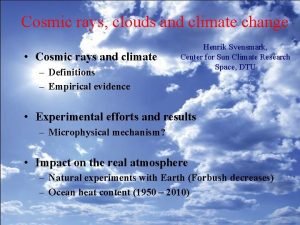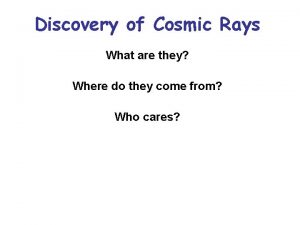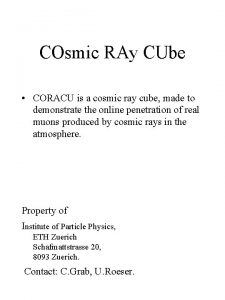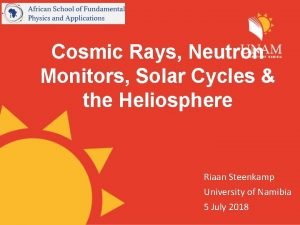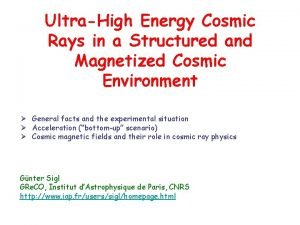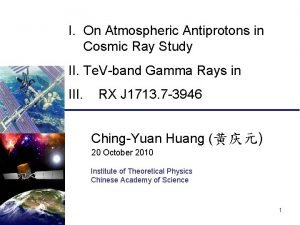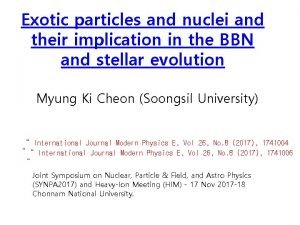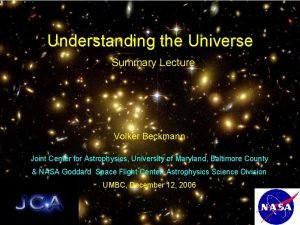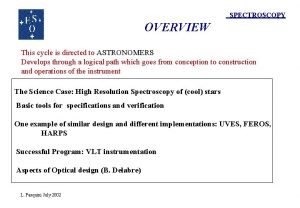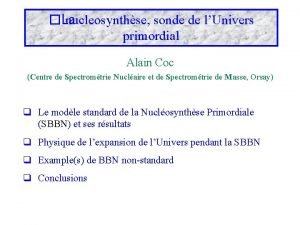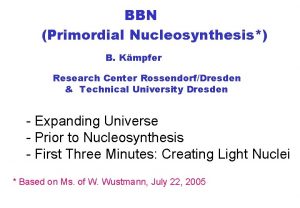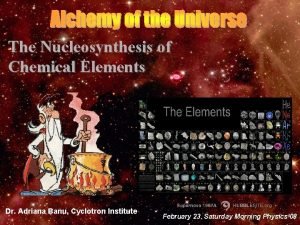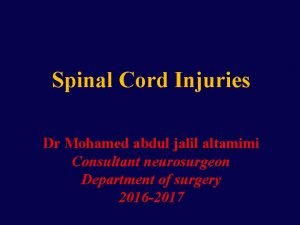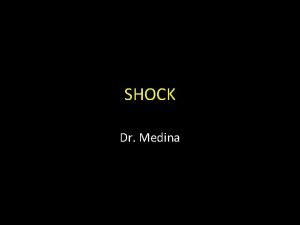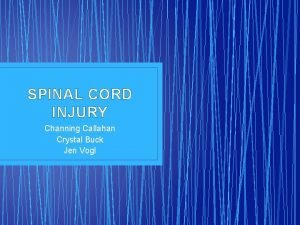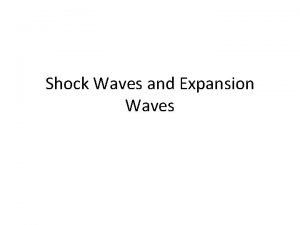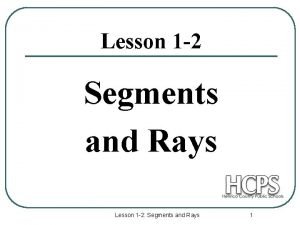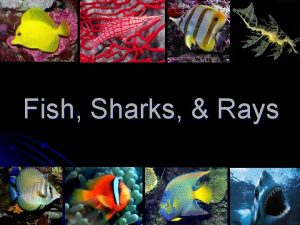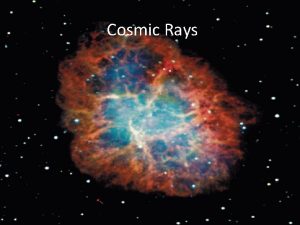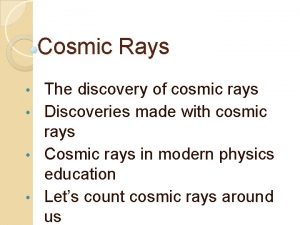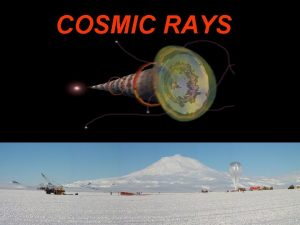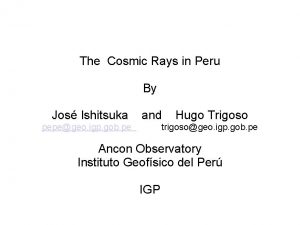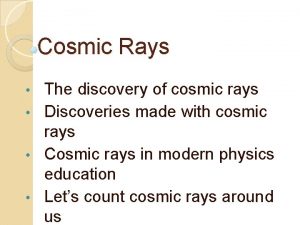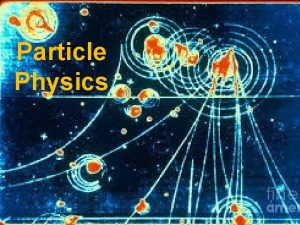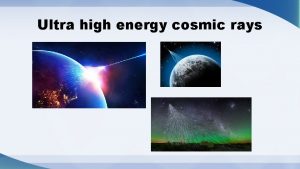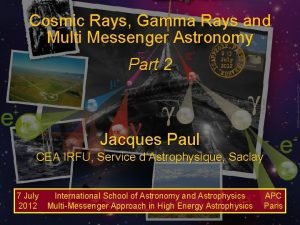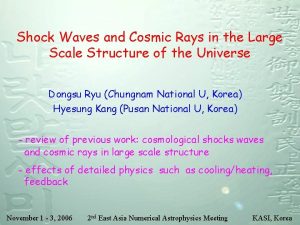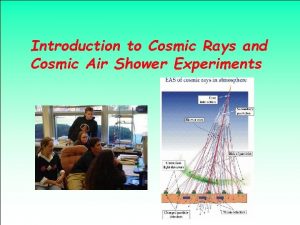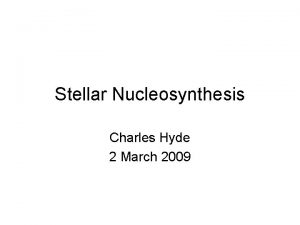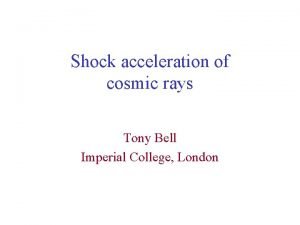Nucleosynthesis Pulsars Cosmic Rays and Shock Physics High




















- Slides: 20

Nucleosynthesis, Pulsars, Cosmic Rays, and Shock Physics: High Energy Studies of Supernova Remnants with Chandra and XMM-Newton John P. Hughes Rutgers University January 8, 2003 201 st AAS Meeting 1

Crab Nebula SN 1054 Time spacing ~6 weeks Polar jet, torus, inner ring (~0. 2 pc) Highly dynamic Wisps move at ~0. 5 c (Hester et al 2002) PSR spin energy, relativistic wind Nature of wisps still debated January 8, 2003 201 st AAS Meeting 2

New Pulsars and CCOs January 8, 2003 Cas A CXOU J 232327. 9+584842 CCO PKS 1209 -51/52 1 E 1207. 4 -5209 424 ms (X-ray) G 106. 3+2. 7 PSR J 2229+6114 51. 6 ms (radio) IC 443 CXOU J 061705. 3+222127 CCO G 292. 0+1. 8 PSR J 1124 -5916 135 ms (radio) RX J 0852. 0 -4622 CXOU J 085201. 4 -461753 CCO 3 C 58 PSR J 0205+6449 65. 7 ms (X-ray) G 54. 1+0. 3 PSR J 1930+1852 136 ms (radio) 201 st AAS Meeting 3

3 C 58 and NS Cooling n n n Crab-like remnant Associated with SN 1181 65. 68 ms PSR (Murray et al. 2002) Distance 3. 2 kpc Spectrum of central source (Slane et al. 2002) – Power law: G = 1. 7 – TBB < 1. 08 x 106 K for 12 km radius neutron star January 8, 2003 n Below “standard” NS cooling curve 201 st AAS Meeting 4

Nucleosynthesis in CC SNe n Hydrostatic nucleosynthesis – During hydrostatic evolution of star – Builds up shells rich in H, He, C, O, and Si – Amount of C, O, Ne, Mg ejected varies strongly with progenitor mass n Explosive nucleosynthesis – Some mechanism drives a shock wave with 1051+ erg through the Fe-core – Burning front T’s of ~109 K cause explosive O- and Siburning – Only affects the central parts of the star – outer layers retain their pre-SN composition January 8, 2003 201 st AAS Meeting 5

Explosive Nucleosynthesis Process T (109 K) Main Products Explosive complete Si-burning 5. 0 “Fe”, He Explosive incomplete Si-burning 4. 0 Si, S, Fe, Ar, Ca Explosive O-burning 3. 3 Explosive Ne/C-burning January 8, 2003 1. 2 201 st AAS Meeting O, Si, S, Ar, Ca O, Mg, Si, Ne 6

Typical Mass Fractions Element O Ne Mg Si S Ar Ca Fe January 8, 2003 Ex Ne 0. 72 0. 13 0. 09 0. 02 Ex O 0. 45 0. 005 0. 30 0. 20 0. 025 0. 02 201 st AAS Meeting Ex Si-i Ex Si-c 0. 40 0. 25 0. 06 0. 05 0. 20 0. 70 7

Overturning Our View of Cas A Hughes, Rakowski, Burrows, and Slane 2000, Ap. JL, 528, L 109. January 8, 2003 201 st AAS Meeting 8

Cas A - Doppler Imaging by XMM n Similar velocity structures in different lines – – – n SE knots blueshifted N knots redshifted Tight correlation between Si and S velocities Fe – Note velocity distribution in N – Extends to more positive velocities than Si or S Willingale et al 2002, A&A, 381, 1039 January 8, 2003 201 st AAS Meeting 9

Cas A – 3 D Ejecta Model “Plane of the sky” “Rotated” Red: Si Ka Green: S Ka Blue: Fe Ka Circle: Main shock Fe-rich ejecta lies outside Si/S-rich ejecta January 8, 2003 201 st AAS Meeting 10

N 63 A n Middle-aged SNR – – – n 34” (8. 2 pc) in radius 2000 -5000 yrs old 2 nd brightest LMC SNR “Crescent”-shaped features – Similar to features in Vela – Clumps of high speed ejecta – Not ejecta dominated n Triangular hole – X-ray absorption – Approx. 450 solar mass cloud – On near side n No PSR or PWN – LX < 4 x 1034 erg s-1 Warren, Hughes, & Slane, Ap. J, in press (20 Jan 2003) January 8, 2003 201 st AAS Meeting 11

DEM L 71 n Middle-aged SNR – 36” (8. 7 pc) in radius – 4, 000 yrs old Rims: LMC composition n Core: [Fe]/[O] > 5 times solar n Ejecta mass: 1. 5 Msun n SN Ia ejecta Hughes, Ghavamian, Rakowski, & Slane 2003, Ap. J, 582, L 95 January 8, 2003 201 st AAS Meeting 12

N 49 B n Middle-aged SNR – 80” (19 pc) in radius – 5000 -10, 000 yrs old n Bright and faint rims – LMC composition – ISM density varies by x 10 n Ejecta – Revealed by equivalent-width maps – Mg & Si rich, no strong O or Ne Park, Hughes, Slane, Burrows, Garmire, & Nousek 2003, Ap. J, in prep. January 8, 2003 201 st AAS Meeting 13

SNR 0103 -72. 6 n Middle-aged SNR – 87” (25 pc) in radius – >10, 000 yrs old (? ) n Circular rim – SMC composition n Central bright region – O, Ne, Mg, Si-rich ejecta – No Fe enhancement Park, et al 2003, Ap. J, in prep. January 8, 2003 201 st AAS Meeting 14

DEM L 71: Shock Physics Nonradiative Balmer-dominated shock Measure post-shock proton temperature X-ray emission from thermal bremsstralung Measure post-shock electron temperature Ha X-ray January 8, 2003 201 st AAS Meeting 15

Constraining the Electron Temperature Fit plasma shock models to 3 spatial zones to follow evolution of Te n Study 5 azimuthal regions with sufficient Chandra statistics and broad Ha component n Available data cannot constrain Te gradients n n Data do determine mean Te Suggest partial to compete temperature equilibration n Rakowski, Ghavamian, & Hughes 2003, Ap. J, submitted January 8, 2003 201 st AAS Meeting 16

Nonradiative Balmer Shocks n n n Nonradiative means that a radiative (cooling) zone does not form Low density (partially neutral) gas High velocity shocks Narrow component: cold H I overrun by shock, collisionally excited Broad component: hot postshock protons that charge exchange with cold HI (Chevalier & Raymond 1978; Chevalier, Kirshner, & Raymond 1980) Ghavamian, Rakowski, Hughes, and Williams 2003, Ap. J, submitted. January 8, 2003 Width of broad component yields post shock proton temperature 201 st AAS Meeting 17

Results on Te/Tp from DEM L 71 Shows trend: higher equilibration for slower shocks n X-ray/Ha results consistent with other purely Ha ones n January 8, 2003 201 st AAS Meeting 18

Future Directions n X-ray expansion (proper motion) – Cas A: done – SN 1006, Tycho: this year – Magellanic Cloud SNRs: in a few years n Ejecta census in LMC/SMC SNRs – Probe the “Life Cycle of Matter” n Longer observations of PWN – Explore range of dynamical variability n More studies of shock physics – Explore variety of high Machnumber shocks January 8, 2003 201 st AAS Meeting 19

The End January 8, 2003 201 st AAS Meeting 20
 Cosmic rays and clouds
Cosmic rays and clouds Cosmic rays discoverer
Cosmic rays discoverer Cosmic rays
Cosmic rays Cosmic rays
Cosmic rays Cosmic rays
Cosmic rays Cosmic waves
Cosmic waves Exotic nucleosynthesis
Exotic nucleosynthesis Primordial nucleosynthesis
Primordial nucleosynthesis Primordial nucleosynthesis
Primordial nucleosynthesis Primordial nucleosynthesis
Primordial nucleosynthesis Primordial nucleosynthesis
Primordial nucleosynthesis Abundance of elements
Abundance of elements Spinal shock vs neurogenic shock
Spinal shock vs neurogenic shock Diferencia entre shock medular y shock neurogenico
Diferencia entre shock medular y shock neurogenico Spinal shock vs neurogenic shock
Spinal shock vs neurogenic shock Spinal shock vs neurogenic shock
Spinal shock vs neurogenic shock Subacute combined degeneration
Subacute combined degeneration Shock waves physics
Shock waves physics Postulates examples
Postulates examples Lesson 2 segments and rays
Lesson 2 segments and rays Caudal fin shark
Caudal fin shark
